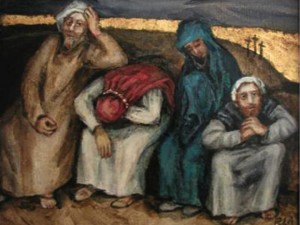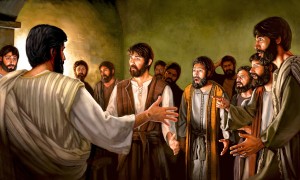Mar
31
On the Resurrection Hypothesis, part 4 of 5: The Disciples’ Belief
Origin of the Disciples’ Belief in Jesus’ Resurrection
To say that the death of Jesus on the cross was devastating to the disciples would be gross understatement. Despite Jesus’ warnings, they had no concept of a Messiah that would die, much less rise up again. Without the resurrection, Jesus’ shameful death could only be seen as humiliating and cursed by God. Jesus could be remembered as a beloved and wise teacher, but certainly not Messiah or God. But, the resurrection transformed disaster into victory. Now, Jesus’ death could be recognized as the means by which forgiveness of sins could be obtained — the ultimate blood sacrifice. Jesus’ being raised by God from the dead invested His death with salvific significance, and His disciples could proclaim Him as Messiah after all.
Paul wrote that the resurrection was central to the Gospel message, and without it the Christian faith meant nothing (I Cor. 15:12-19). Even the most skeptical scholars agree that at least the belief that Jesus had risen from the dead was at the core of the earliest Christian faith. The Christian Way could never have begun, let alone spread, without it.
So, what caused this belief? If Jesus had not actually been resurrected, then there must be another, better explanation for it, right? Jesus’ disciples (i.e., while He was alive on earth) were all Jewish, so what about the teachings of Judaism? Three places in the Old Testament (Isaiah 26:19; Ezekiel 37; Daniel 12:2) reflect the Jewish doctrine of resurrection. By Jesus’ time, belief in bodily resurrection was a source of hope for many. In Matthew 22:23-33 we even see Jesus siding with the Pharisees against the Sadducees on this matter. So, the concept was at least present in Jewish religious thought.
But, their understanding differed in two major respects from what belief in Jesus’ resurrection required — specifically, in the When and the Who of resurrection.
1) *Jewish doctrine of resurrection was always in regards to the end of world history, never sooner.* Every OT instance of the dead being revivified resulted in a return to mortal life, but the individual(s) would eventually die again. The resurrection to immortality and glory would not happen until God brought about the end of the world. This is the way Jesus’ disciples believed (Mark 9:9-13; John 11:24), so the idea of an actual resurrection before the world’s end was alien to them. Faced with Jesus’ death, they most likely would have enshrined His tomb and waited in anticipation of resurrection on the final day. It was extremely improbable for them to have come to believe He had already been raised.
2) *Jewish doctrine of resurrection was always about the general resurrection of the people, never a single individual.* Whether the entire human race, or all of Israel, or only the righteous, the people’s resurrection was never believed to depend upon the Messiah being resurrected first. Again, the disciples would have waited for the day when God raised Jesus to glory with all the righteous of Israel.
Thus, the disciples’ belief in Jesus’ resurrection cannot be attributed to prior Judaical beliefs.
Could the disciples have been led to their conclusion by certain events following the burial? For example, some have postulated that the disciples had visions of the eschatological Son of Man and interpreted them in terms of the Jewish teaching discussed above. The empty tomb story was then a legend resulting from their belief in Jesus’ resurrection. Despite the fact that this goes against the evidence, how likely is it that such experiences could have caused their belief?
We need to look briefly at the issue of hallucinations again. Hallucinations can only contain that which is already in the mind. Any visions that the disciples had would reflect the Jewish concepts of immortality noted above. They would likely have projected a glorified Jesus in “Abraham’s bosom”, where the righteous dead wait for the final resurrection. But, we have also noted the two significant ways in which Jesus’ resurrection is inconsistent with those concepts.
How then would the disciples’ doctrine of resurrection have developed? An empty tomb by itself could lead to a belief that Jesus was merely translated straight to heaven — a miracle applicable to the recently deceased, as well as the living — like Enoch or Elijah. In contrast to a translation, a resurrection involved a dead person being raised up in the spatio-temporal world to eternal life. Even if discovery of the empty tomb had been followed by hallucinations of Jesus in glory, it is doubtful they would have concluded that He had risen from the grave. More likely, they would have thought that He appeared to them from heaven, where God had translated Him.
Other skeptics have argued that a death-translation model came first, with the death-resurrection scheme developing from it later. The story of the empty tomb then becomes a translation story and postmortem appearances are interpreted as mere visions of the exalted Christ. But, considered more closely, a primitive death-translation scheme leading to the disciples’ belief in and proclamation of Jesus’ resurrection just doesn’t make sense. Plus, there is no evidence to support the primitiveness of a death-translation model without a literal resurrection. To the contrary, specialist in resurrection studies Gerald O’Collins confirms that, if anything, the text indicates the opposite pattern.
The evidence points to the disciples proclaiming Jesus’ resurrection (contrary to Jewish religious thinking) and not a mere translation of Jesus (which would have been compatible with Jewish doctrine). This argues against the disciples experiencing hallucinatory visions of Christ as the cause for their belief in Jesus’ physical resurrection. This belief simply cannot be explained, either through Judaism or the church, unless the resurrection of Jesus is historical fact.
To be concluded in Part 5…
===========
Credit where credit is due: The material for defending the historical burial and resurrection of Jesus was primarily adapted from William Lane Craig’s “Did Jesus Rise from the Dead?” in the book Jesus Under Fire, eds. J.P. Moreland and Michael J. Wilkins.

















